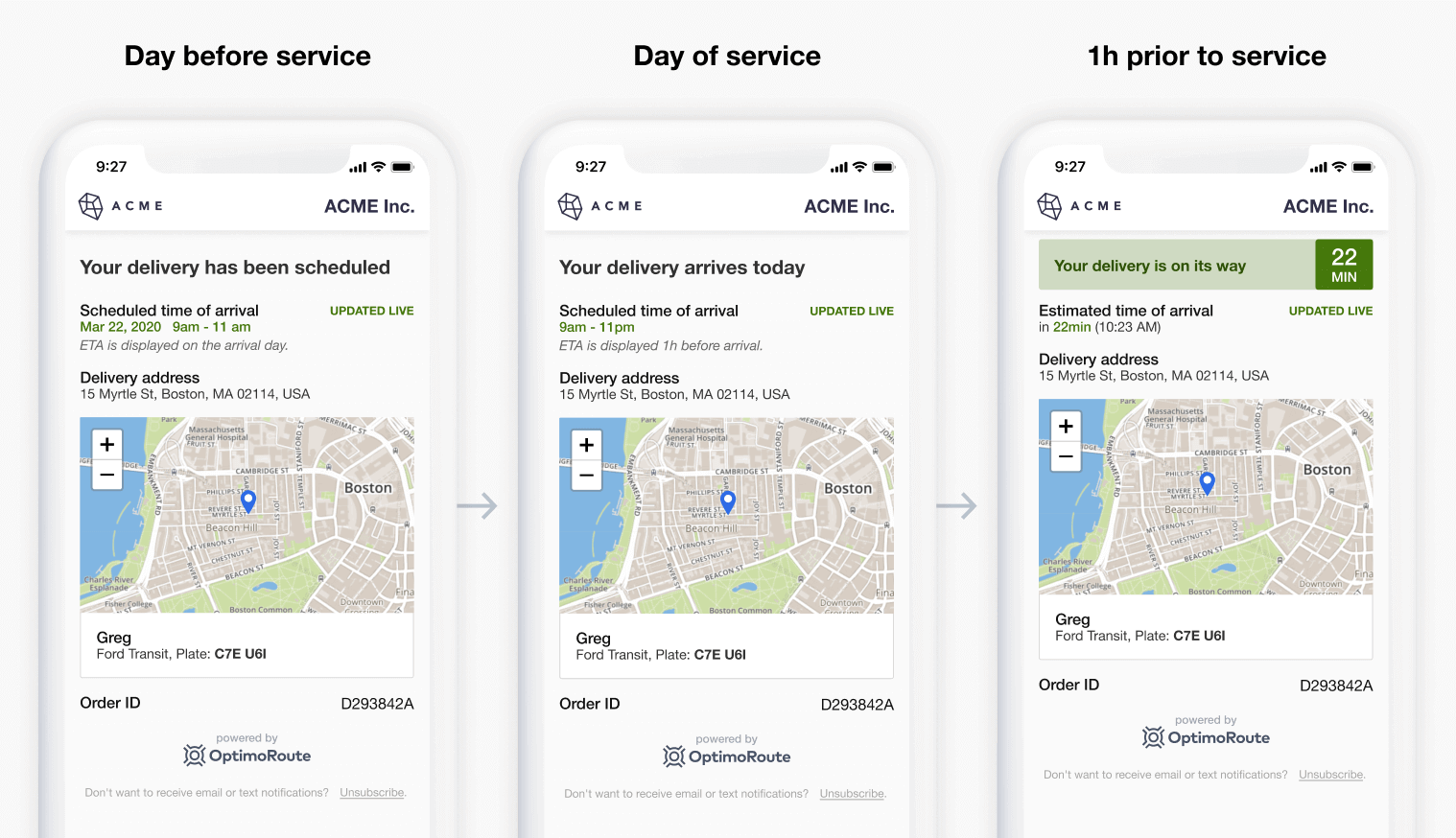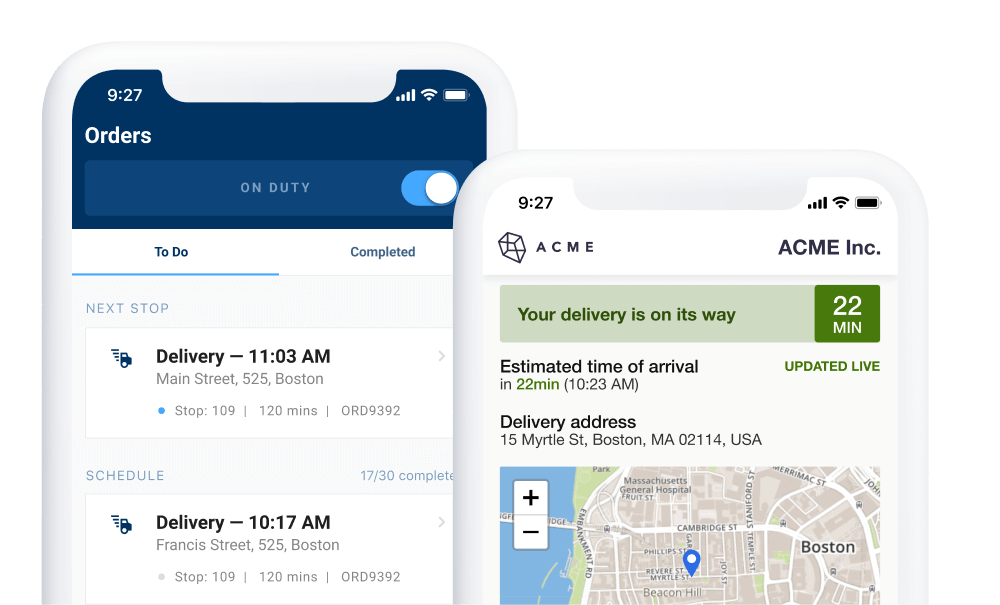ETA & ETD: What’s the Difference Between Estimated Time of Arrival and Estimated Time of Departure?

“What’s your ETA?” is a common question. We use it to find out when a friend will arrive at a restaurant or when a maintenance professional will show up to repair an appliance. When you ask for an ETA, you’re asking when your friend or repairman will knock on your door, right? Not exactly.
As you will learn in this article, estimated time of arrival is actually a lot more complicated than it seems, and it is often used incorrectly. Businesses and consumers rely on arrival and delivery estimates for planning, scheduling, and much more, but sometimes it feels like nobody is speaking the same language.
In this article, we’ll simplify the most commonly requested logistics estimates that shippers need to know and break down which of your customers needs which one (even if they’re using the wrong shipping term). Plus, we’ll show you how to use OptimoRoute to deliver highly accurate order updates with almost no effort.
What Exactly Is ETA (Estimated Time of Arrival)?
In the logistics industry, ETA (estimated time of arrival) indicates when a vehicle, cargo ship, or other modes of transportation will arrive at its final destination. Arrival estimates are used to give customers an approximation of when the vehicle carrying their goods will arrive at their location. ETA is also used to let customers know the expected time that a service professional will arrive to do a job (such as a repairman fixing an air conditioner).
ETA vs ETD: What’s the difference?
The difference between ETA vs. ETD is that ETA is the estimated time of arrival and ETD is the estimated time of departure or the estimated time of delivery. ETA always refers to the time a transportation vehicle or vessel will arrive at its final destination, but as shown above, ETD can mean one of two different things:
- Estimated time of departure, which is the beginning of the last-mile delivery journey, when a package will leave a storage facility.
- Estimated time of delivery, which refers to the final point in a logistics supply chain, or the moment a product is handed over to the consignee. Estimated time of delivery is most frequently used by couriers and package/product delivery companies. It is important to note that delivery estimates are different from arrival estimates. For example, if a delivery truck arrives at a high-rise office building at 1 pm, packages may not actually be delivered to certain floors or businesses within that building until 1:30 pm.
If you’ve ever encountered a miscommunication, thanks to the dual meaning of “ETD,” you’re not alone. This is why it’s a best practice to write out the full term for ETD instead of using the acronym when you’re speaking to anyone outside of your own company.

The final estimate your customers may want is the ECT or estimated completion time. ECT is technically the same as an estimated time of delivery, but it is typically used in the service industry and not by couriers. ECT, like estimated time of delivery, refers to the moment when a transaction is completed.
ECT is important for service and maintenance professionals where an individual appointment may take several hours. For example, a pool maintenance professional may have an ETA of 2 pm for a job that is anticipated to take two hours. In this case, the ECT for the same job would be 4 pm.
Finally, it’s useful to remember that the estimated time of arrival isn’t necessarily the actual time of arrival (ATD), nor is the estimated time of departure the actual time of departure. These estimates are often incorrect, so make sure to clarify to customers that the ETA or ETD isn’t a guarantee that their goods will arrive at that time.
Use OptimoRoute to Provide the Most Accurate ETA, ETD, and ECT
The easiest way to calculate logistics estimates and avoid any confusion caused by ETA, ETD, and ECT is to use software. Here’s how to use the live-tracking and planning features in OptimoRoute to calculate every estimate both you and your customer need with a high degree of accuracy—and very little effort.
Calculate departure time with advance planning
Advance planning is literally planning and scheduling as early as possible (days, weeks, or even a month in advance). Dispatchers can use early planning to figure out exactly when a new order will depart a warehouse or storage facility. They can then share that information with customers and internal teams.

All a dispatcher needs to do is upload orders from an Excel sheet or other document, input the driver constraints (which can be saved for future planning), and click “Plan routes.” In a matter of seconds, you’ll have optimized routes and schedules, and you’ll be able to let customers know precisely when their order is going to depart your warehouse or storage facility. You can also make manual adjustments to routes at any time. You can plan up to five weeks in advance and replan as many times as you want when new orders come in.
See arrival times with live tracking
Live tracking, or real-time tracking, is a feature that lets you (and your customers) see where a delivery driver is along their route.
Live GPS tracking takes the guesswork out of ETAs for dispatchers and fleet managers. Real-time visibility doesn’t guarantee your drivers won’t run into traffic or get a flat tire while they’re en route, but it does ensure that if anything goes wrong, dispatchers will know immediately. Live tracking helps dispatchers troubleshoot unavoidable delays and keep on-time delivery rates as high as possible.

OptimoRoute shows dispatchers planned routes using a straight line, with different colors for each driver. When a driver departs, dispatchers see a trail of “bread crumbs,” or a dotted line, that indicates where that driver is in real time.
OptimoRoute clearly shows when a driver is expected to arrive at upcoming stops, how long they took to complete deliveries at previous stops, and whether they are running early, late, or on time. This information is accessible later in easy-to-understand analytics, too, so dispatchers can adjust schedules or routing in the future based on hard data.
Show customers when to expect delivery with real-time tracking notifications
OptimoRoute’s real-time tracking notifications are the customer-facing part of the live tracking we just mentioned. Real-time tracking lets customers see where drivers are along their route with a map view and provides text or email updates when the driver departs, is getting close, and has completed a delivery.
Surveys have shown that 88% of consumers want real-time tracking. Nobody appreciates looking at the same “out for delivery” notification for six straight hours when they’re anticipating an important delivery. The best estimate you can give customers is one that’s highly accurate, and real-time tracking is as accurate as it gets.

You can customize messages in OptimoRoute and then set them to automatically be sent to customers when a package or service professional is on the way. Your customers will know the minute their order is expected to arrive based on current conditions, and if anything changes, they’ll be able to see it right away.
Easily monitor estimated completion time with live tracking
As we mentioned, estimated completion time refers to the time a service request is expected to be finished. Field service and maintenance companies can easily monitor these times using live tracking. The screenshot below shows a dispatcher’s view of service professionals’ live status. Using OptimoRoute, a dispatcher can quickly and clearly see who is on time and which jobs are taking longer than expected.

If a repairman shows up for a job that was anticipated to take 30 minutes to find that the problem is much larger than expected, the dispatcher can use dynamic replanning to reassign their next appointment to another repairman, if needed. Service windows can be customized to the type of job being performed and even to individual employees, if some tend to work more efficiently than others. Dispatchers can also access these timetables in a condensed analytics view later on to see if service window times need to be adjusted for the whole team going forward. Analytics will help managers see if certain types of repairs routinely take 90 minutes as opposed to 60 minutes.
Additionally, OptimoRoute streamlines customer updates, so dispatchers can focus on keeping their team on track and on time. Since you can set up your OptimoRoute account for customers to get real-time tracking updates, your dispatcher won’t have to worry as much about notifying customers when their repairman is running late. Although, you can always go the figurative extra mile and give them a call if you deem it appropriate.

Reduce your operational costs by 30%
Increase delivery capacity by 43%
Plan 7x faster
Who Needs ETA vs. ETD, and Why?
Departure, arrival, delivery, and completion estimates are all important, but different people use this information in different ways. Once you understand which of your customers rely on which estimates, you’ll know how to tailor communications to meet their specific needs.
Recreational customers
Private consumers simply want to know when their package will arrive on their doorstep or when their service professional will begin work. For service and repair companies, this is very straightforward—your customer wants an ETA.
For courier companies and delivery teams, it’s a bit more complicated. Whether you’re delivering consumer goods or a hot pizza, your customer technically wants to know the estimated time of delivery for that order, but consumers are inclined to refer to this as an ETA.
As we mentioned, estimated time of arrival refers to the time a delivery vehicle will arrive at the delivery destination. In this particular case, it’s okay to give the estimated time of arrival as opposed to the estimated time of delivery because the delay between a driver pulling into a driveway and actually knocking on a customer’s door is a matter of minutes or even seconds. The ETA and ETD, in this case, are essentially the same; what private consumers want to know is when they’ll have their purchase in hand.
The key to providing estimates for recreational consumers is to be as accurate as possible even before a purchase is made. More than half of shoppers say they consider shipping options when browsing for products. If you offer two-day shipping, you need to be able to deliver on your promise; otherwise, you’re likely to lose that customer and get a bad review (which could cause you to lose additional business).
Once an order leaves your warehouse, store, or restaurant, you can use OptimoRoute to give customers real-time visibility, so they know the minute their package will arrive.
Commercial customers
Commercial customers of courier and transportation services are likely to want both an ETA and an estimated time of departure for packages. This is particularly true if you are sending products internationally or over a long distance. Commercial customers understand that shipments can get held up going through customs or can face weather-related setbacks, so they use departure times to isolate where a package is when real-time tracking isn’t available.
Commercial customers are often juggling a large number of both incoming and outgoing purchase orders. The more information you can give commercial buyers, the better they can plan warehouse space, schedule employees, and keep their own operations running smoothly.
If you run a service or repair business, such as an HVAC maintenance company that services office buildings, your customers will definitely want an ETA and may also ask for an ECT. Depending on the type of commercial space your client works in, they may need to schedule an employee to escort you through various parts of the building. It’s best practice to give commercial clients an estimate of how long a job will take as well as when you’ll be able to start that service.
Dispatchers
Dispatchers don’t need estimates—they need real-time visibility. Dispatchers are the point person for drivers and service professionals in the field, and when one of them hits a roadblock or gets tied up at a delivery, it’s the dispatcher’s job to replan. It’s nearly impossible for dispatchers to do their job effectively if they can’t see where every member of their team is in the field. This is part of what makes OptimoRoute such a valuable tool for logistics companies: it gives dispatchers clarity in ever-changing situations.
It is important to note that while dispatchers need highly accurate location tracking for their own purposes, they may also need the ETAs, ETDs, and ECTs provided to customers. Some dispatchers are at least partially responsible for keeping customers updated about changes to an ETA, so they’ll need to know what information has been provided to each customer.
Deliver a Better Customer Experience With OptimoRoute
You’ve probably heard the phrase “knowledge is power,” and when it comes to logistics, knowing exactly where your drivers and packages are gives you the power to deliver a superior customer experience. Get the knowledge you need with OptimoRoute’s live tracking, advanced analytics, and driver insights. We offer competitive pricing and a 30-day free trial, so you can get started today.
Try OptimoRoute™ for Free
No installation or credit card required


